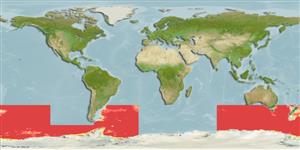Classification / Names
Common names from other countries
Main reference
Size / Weight / Age
Max length : 50.0 cm TL male/unsexed; (Ref. 1371)
Environment
Marine; bathypelagic; depth range 500 - 3800 m (Ref. 1371), usually 1000 - 2000 m (Ref. 1371)
Climate / Range
Deep-water, preferred -2°C (Ref. 107945); 36°S - 79°S, 80°E - 14°W (Ref. 1371)
Distribution
Short description
Dorsal
spines
(total): 0;
Anal
spines: 0. Head profile rounded; snout short, blunt. Scales deciduous, with 1 to 3 divergent rows of small, thin spinules uniformly covering almost all of the body; scales absent over most of the snout and in wide patches on the head surrounding large pores of sensory lateralis system. Pyloric caeca rather long and slender, about 9 to 10. Overall color is dark brown to brownish black.
IUCN Red List Status (Ref. 115185)
Threat to humans
Harmless
Human uses
Fisheries: of no interest
More information
Common namesSynonymsMetabolismPredatorsEcotoxicologyReproductionMaturitySpawningFecundityEggsEgg development
Age/SizeGrowthLength-weightLength-lengthLength-frequenciesMorphometricsMorphologyLarvaeLarval dynamicsRecruitmentAbundance
ReferencesAquacultureAquaculture profileStrainsGeneticsAllele frequenciesHeritabilityDiseasesProcessingMass conversion
Tools
Special reports
Download XML
Internet sources
Estimates of some properties based on models
Phylogenetic diversity index
PD50 = 1.0000 many relatives (e.g. carps) 0.5 - 2.0 few relatives (e.g. lungfishes)
Trophic Level
3.4 ±0.40 se; Based on food items.
Resilience
Low, minimum population doubling time 4.5 - 14 years (Preliminary K or Fecundity.)
Vulnerability
Moderate to high vulnerability (55 of 100)
Price category
